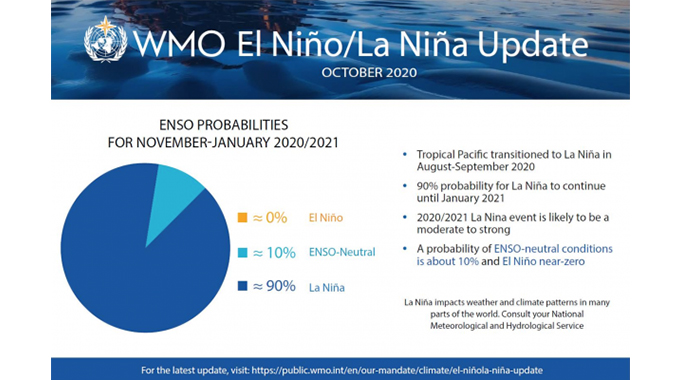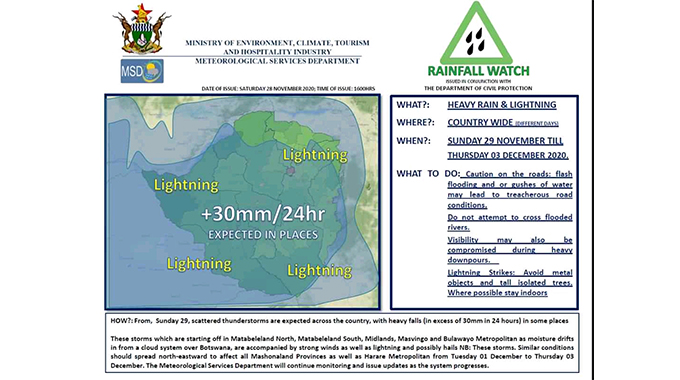Scattered thunderstorms are expected across the country, with heavy rainfall in excess of 30mm/24hr between Sunday 29 November and 03 December 2020 though in different days, the Meteorological Services Department said on Saturday.
In an alert, the department said the storms are starting off in Matabeleland North, Matabeleland South, Midlands, Masvingo and Bulawayo Metropolitan. The rains are accompanied by strong winds, lightning and possible hails.
“These storms which are starting off in Matabeleland North, Matabeleland South, Midlands, Masvingo and Bulawayo Metropolitan as moisture drifts in from a cloud system over Botswana, are accompanied by strong winds as well as lightning and possibly hails,” said the Meteorological Services Department.
“Similar conditions should spread north-eastward to affect all Mashonaland Provinces as well as Harare Metropolitan from Tuesday 01 December to Thursday 03 December.”
Motorists have been urged to be cautious as flash floods may lead to treacherous road conditions and compromised visibility during heavy downpours.
“Flash flooding and or gushes of water may lead to treacherous road conditions. Visibility may also be compromised during heavy downpours.”
The public has also been cautioned against crossing flooded rivers and have been urged to avoid metal objects and tall isolated trees, and stay indoors where possible.
Meanwhile, the rains could bring relief to urbanites particularly those in Bulawayo who are facing long hours of dry taps as major water sources have been decommissioned. Farmers in particular, who benefited from the Climate-Proofed Presidential Inputs Scheme, have been preparing their Pfumvudza/Intwasa plots meaning planting can start as soon as good rains are received.
Scientists have projected a good season as early signals of moderate La Nina – the large-scale cooling of the ocean surface temperatures in the central and eastern equatorial Pacific Ocean – have been identified though some nuances can take place.
The projection of the occurrence of the La Nina phenomenon which likely brings rainfall in Southern Africa is also used by governments for planning in climate sensitive sectors like agriculture, health, water resources and disaster management.
A possible good wet season is of national significance to Zimbabwe, a country which is already suffering from the effects of the 2019/2020 crop failure and the subsequent food insecurity.
Farmers have on record lost large herds of cattle to drought and national parks haven’t been spared as soaring temperatures and drought have led to loss of elephants particularly in the Hwange National Park.
The World Meteorological Organisation said that the La Nina phenomenon is going to last into next year, affecting temperatures, precipitation and storm patterns in many parts of the world.

The positive impacts of La Nina on Southern Africa will possibly stimulate economic growth in countries such as Zimbabwe as yields are likely to be high, for the benefit of agro-based industries.
With the ongoing Pfumvudza/Intwasa program as well, food production is expected to improve and prevent the importation of grain to augment national reserves.
Although El Nino and La Nina are not the only factors that drive global and regional climate patterns, there are high hopes of good rains driven by the phenomenon and that there is not going to be any nuances which can affect the already projected good cropping season.





Do you have a spam problem on this website; I also am a blogger, and I was
wanting to know your situation; we have created some nice procedures and we
are looking to swap methods with other folks, why not shoot me an email if interested.